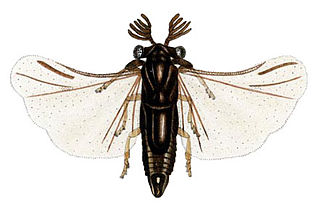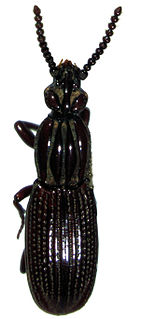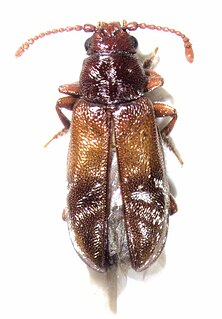
The Strepsiptera are an order of insects with nine extant families that include about 600 described species. They are endoparasites in other insects, such as bees, wasps, leafhoppers, silverfish, and cockroaches. Females of most species never emerge from the host after entering its body, finally dying inside it. The early-stage larvae do emerge because they must find an unoccupied living host, and the short-lived males must emerge to seek a receptive female in her host. They are believed to be most closely related to beetles, from which they diverged 300–350 million years ago, but do not appear in the fossil record until the mid-Cretaceous around 100 million years ago.

Rhysodidae is a family of beetles, consisting of more than 350 species in about 20 genera.

Endopterygota, also known as Holometabola, is a superorder of insects within the infraclass Neoptera that go through distinctive larval, pupal, and adult stages. They undergo a radical metamorphosis, with the larval and adult stages differing considerably in their structure and behaviour. This is called holometabolism, or complete metamorphism.

Myxophaga is the second-smallest suborder of the Coleoptera after Archostemata, consisting of roughly 65 species of small to minute beetles in four families. The members of this suborder are aquatic and semiaquatic, and feed on algae.

The Tenebrionoidea are a very large and diverse superfamily of beetles. It generally corresponds to the Heteromera of earlier authors.

Staphylinoidea is a superfamily of beetles. It is a very large and diverse group with worldwide distribution.

Lepicerus is a genus of myxophagan beetles containing three described species in the family Lepiceridae; it is the only extant genus in the family, with another genus, Lepiceratus only known from fossils. Extant species occur in the Neotropics, from Mexico south to Venezuela and Ecuador. Fossils referrable to the genus are known from the early Late Cretaceous of Southeast Asia.

Chaetosomatidae is a small family of beetles, in the superfamily Cleroidea. There are three extant genera, two of which are endemic to New Zealand with the other (Malgassochaetus) native to Madagascar. Members of this family are predaceous on wood-boring insects.

Cavognathidae is a family of beetles, in the superfamily Cucujoidea. It contains a single genus, Taphropiestes with around a dozen species known from South America, Australia and New Zealand. In Australian and New Zealand species adults and larvae have been found living in bird nests, but their ecology is unclear, but they are possibly scavengers.
Hobartiidae is a family of beetles, in the superfamily Cucujoidea. There are only two known genera Hobartius and Hydnobioides, with six species, five of which are native to Australia, and one species of Hobartius native to Chile and Argentina in South America. Members of the family are mycophagous, living in rotten, fungus infested logs of Araucaria, Nothofagus, and Eucalyptus, where they feed on the fruiting bodies of basidiomycetes.
Lamingtonium is the only genus in the family Lamingtoniidae, of the superfamily Cucujoidea. It contains three species endemic to Australia. The holotype of the type species was collected on at Lamington National Park, Binna Burra, Queensland under the bark of a dead tree. The adults and larvae of two species have been found associated with basidiocarps of fungi belonging to the family Polyporaceae.

Helotidae is a family of beetles, in the suborder Polyphaga. The family includes about five extant genera, Helota MacLeay, Neohelota Ohta, Afrohelotina Kirejtshuk, Metahelotella Kirejtshuk, and Strophohelota Kirejtshuk. Helotidae are found mainly in the Old World tropics and are absent from Australia and Madagascar. The antennae are clubbed on the final three segments and is retractable within grooves under the head. The wings have reduced venation with just 4 anal veins. Helotids are known to be associated with sap, fruit and flowers, and the larvae of some species are known to bore into wood in order to pupate.
Smicripidae is a family of beetles, in the superfamily Cucujoidea. The common name for this family is palmetto beetles. The family only has one extant genus, Smicrips, with six extant species native to tropical and subtropical regions of the Americas and extinct species from the Eocene of Europe and one extinct genus, Mesosmicrips, known from the mid Cretaceous aged Burmese amber. Smicrips larvae are usually found amongst decaying vegetation, while adults are typically found on infloresences, especially those of Arecaceae (palms), althought associations with flowers of Fabaceae, Passifloraceae, Bombacaceae and Cactaceae (cactus) have also been recorded. Their diet is unknown.

Monotomidae is a family of beetles in the superfamily Cucujoidea. The family is found worldwide, with approximately 240 species in 33 genera. The ecological habits of the family are diverse, with different members of the group being found under tree bark, in decaying vegetation, on flowers and in ant nests. Their ecology is obscure, while at least some species are mycophagous, feeding on the fruiting bodies of ascomycete fungi, Rhyzophagus are predators on bark beetles and possibly Phoridae larvae, with the larvae of some species also being mycophagous.
Aspidytes is a genus of aquatic beetles in the family Aspidytidae, first recorded in 2002 from specimens in South Africa. The genus contains the single species Aspidytes niobe. Originally a second species from China was placed in the same genus but has later been transferred to Sinaspidytes. The aquatic beetle is 6.5 - 7.2 mm long and lives in hygropetric habitats.

Agapytho is the only genus of beetles in the family Agapythidae. The genus contains a single species, Agapytho foveicollis, which is endemic to New Zealand. Larvae and adults are found on sooty mold growing on Nothofagus trees. Gut contents indicate that at least adult Agapytho consume the sooty mould as part of their diet.

Metaxina is the only genus in the beetle family Metaxinidae. Its only species is Metaxina ornata. It endemic to the South island of New Zealand, where it is associated with sooty mold growing on Nothofagus trees. Both the larvae and adults are likely predaceous, feeding on insects and other arthropods. It is considered to be a member of the superfamily Cleroidea. Genetic studies have suggested that Metaxina should be considered a member of Chaetosomatidae, rather than constituting its own family.
Myrabolia is the only genus in the beetle family Myraboliidae in the superfamily Cucujoidea. It has about 13 species, found in Australia. Adults and possibly larvae live under the bark of Eucalyptus trees.

Priasilphidae is a family of beetles in the superfamily Cucujoidea. They have a Gondwanan distribution, with the three known genera Chileosilpha, Priasilpha and Priastichus being native to Chile, New Zealand and Tasmania respectively. Most species are flightless, lacking wings. Priasilphids inhabit decaying wood and moss in forest habitats. They are likely mycophagous, feeding on fungi.

Aspidytidae is a family of aquatic beetles of the suborder Adephaga, described in 2002 from specimens in South Africa and China. There are only two known species in the family and these were originally described in the genus Aspidytes, but later the new genus Sinaspidytes was erected for the species found in China. The family can also be referred to by its trivial name cliff water beetles.














